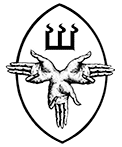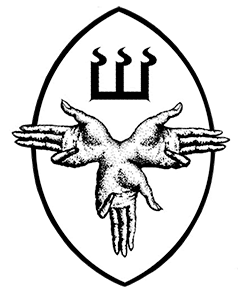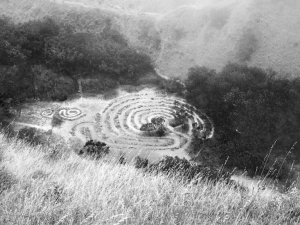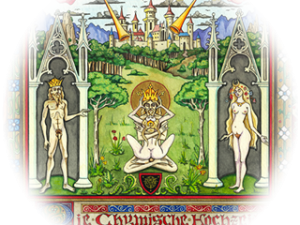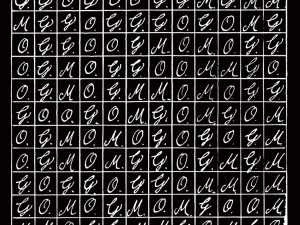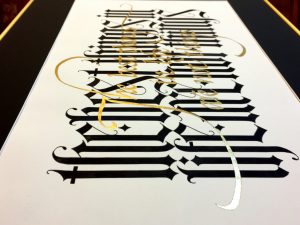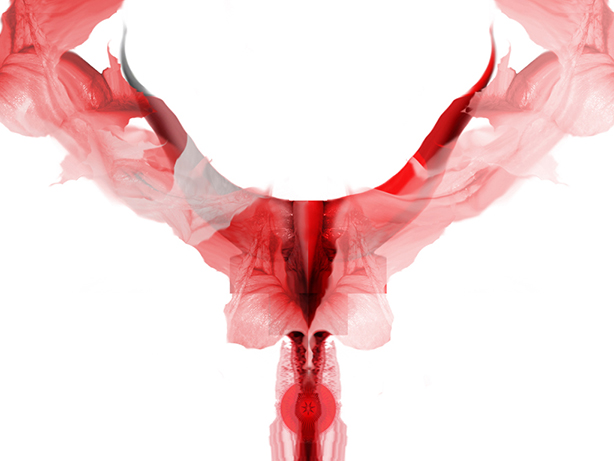
Your forthcoming book The Marks of Teth treats for the first time some very important principles of magical practice, particularly from the perspective of a Priestess of the Mysteries of Babalon. How did this work coalesce, and what are its most important aspects?
The book is the product of over 25 years of work; it gets to the heart of what it means to be a Priestess of Babalon and how one can develop magically within the current over a lifetime. The concept of a progressive, initiatic sex magical priestesshood was something I instinctively and intuitively strived towards, although at the start it was extremely unclear to me how it might function. Defining oneself as a female sexual theurgist can be extremely problematical, since the position of women’s sexuality and spirituality within the western magical traditions is so enmeshed with structural/prejudicial biases and outworn stereotypes. These problems become even more complex and acute when one’s work is concerned with sex magic, and particularly when working with the Babalon current.
From the first contacts and experiences with the current I sensed a vast sexual Arcanum submerged within it, but I had an overwhelming sense that I would’t find deeper understanding of this in terms of a progressive path within any mainstream magical order. This wasn’t any kind of arrogance on my part, more about trusting an inner daemon that inspired solitary magical practice. Starting from within a basic practice of western ceremonial techniques, I discovered I had a faculty for entering trance states very easily and this was producing phenomena directly relevant to the Babalon current. This quickly took on an unstoppable momentum; I became completely immersed within these inner explorations that ended up stretching over decades. The material manifesting through the practice possessed an inner integrity and cohesion that made sense, to me at least, and so I felt I had to see it through to see where it lead. The book is thus an extension of my magical records and outlines the elements I’ve constructed within my practice that have created a germinal but cohesive system, which I hope may be of use others in navigating these lesser explored, liminal realms within female sex magic.
What are some of the flaws of the extant corpus of occult doctrines of priestesshood and female sex magic?
During the occult revival in the west, aversions to unfettered female sexuality inherited from Judeo-Christian religious paradigms was challenged on the surface, yet many restrictive influences continued to distort perceptions of esoteric feminine sexuality. There’s also the problem that many texts or teachings extant on the roles of women within sex magic s(uch as the those derived from the Tantras, Taoism, Alchemy, et cetera) were created originally largely by and for male practitioners within Brahminic, patriarchal structures. Many aspects of which have been incorporated and reinterpreted within contemporary praxis of Thelemic/Typhonian traditions again predominantly by male practitioners.
Movements in Modern Wicca/Neo Paganism, chaos magic, and other schools of magic started to address these imbalances. But in terms of female theurgy, the inherent male bias and embedded stereotypes within esoteric traditions have caused a lack of development of ‘process’ and foundational formulations of the unique qualities of female physical and occult anatomy within sex magic. These are areas I feel still need attention and development. Kenneth Grant’s writings have been extremely valuable in terms of bringing together material on the ancient and contemporary praxis associated with a ‘hidden egregore’ of the Ophidian current that infuses the magic of Babalon, outlining practices which the priestesses used in LHP Tantric, Voudon or Thelemic rites.
But again, how all these rites and techniques could form part of a cohesive, progressive practice for women within a new aeon perspective was still for me not clear. Qualification for the role of ‘Scarlet Woman’ is often presented within the work of Crowley as that of being simply sexually available with a faculty for entering trance states. This is at odds with personal experiences of the Babalon current which revealed a vast and complex system of sex magical etheric/physical ‘technology‘. That Crowley advocated the use of prostitutes (presuming them to be more openly libidinous) and uninitiated women, shows a great lack of technical insight regarding sex magic.
Grant’s work again did much to rebalance and redress Crowley’s omissions. However, the absence of female autonomous and active positions within western magical systems although gradually being challenged and addressed has hampered progress. My working definition of Babalon is that Her magic is involved with developing and manifesting a fully activated ‘sex magical body.’ This definition holds true for any individual within the gender spectrum; there are many mysteries to be developed by all of her devotees. The Babalon current radically challenges orthodox perceptions of sexuality and is a wholly liberating force that incorporates all gender and sexual orientations. However within the book I felt that some very fundamental precepts concerning female sex magic needed to be addressed and so it is focused on Babalon as experienced through the female body.
Many previous sex magic concepts have dwelt to excess in the realms of the mind, rather than the embodied or somatised practice it would seem to require.
My approach has been based on personal experiences, within which Babalon is perceived as an evolutionary spearhead of a primordial Ophidian, feminine sex magical gnosis which has had to function particularly in the west largely on the inner planes, a hidden egregore which has many aspects to its current. The magic of Babalon and her cup is key in formulating the process of melding all the diverse streams within the egregore and creating an elixir which contains the quintessence of all of the initiatic currents of female sexuality which are crystallized within the ‘Body of Babalon’.
Babalon’s initiatic mysteries of transubstantiation and embodiment for female practioners requires a very definitive and complex syzygy between physical and etheric elements which are synthesized within the sexual elixirs. Common sense dictates that female sex magical practice should be primarily formulated by women but this obviously key element has often been absent from the corpus of sex magical literature. However, much of the incredibly valuable work done by many pioneering female occultists I’ve felt was not nuanced or developed enough within this very specialized area to build a practice from. So, what I have been doing has involved an attempt to get to the esoteric core of the arcana of female sex magic from which new structural models of female magical sexuality can be explored and developed.
The work demanded an experiential, heuristic approach and I’ve developed a practice wrought from many years of invocatory work. This revealed a path that is extraordinarily demanding, requiring the development of many highly technical skills and disciplines. The ‘magical body’ of the Babalon priestess must be an autopoietic construction, a self-created entity forged in ecstatic syzygy with the current, rather than an entity that exists primarily in relationship to a partner within polarity work. There are many epistemological, theological and phenomenological considerations in terms of the relationships between female sexuality and the esoteric path which demand much deeper exploration. I’m expecting there will be a lot of debate in coming years which will reflect many emergent manifestations from female practioners.
The work featured in The Marks of Teth has been built on material received through many years of invocation during which Babalon revealed many of sex magical ‘mechanisms’ and initiatory dynamics within her mysterium. These revelations were received in sexual trance states which although often frenzied and dramatic, were also highly technical and melded with primal roots of the egregore to create a hieratic, etheric/physical language that is derived directly the pure energetic sexual source of Babalon’s magic.
Working from this primal, physical, pre-linguistic source created the necessary openness, clarity and foundation to develop an approach that felt authentic. Further inner plane explorations revealed what seemed to be vital practices and physical/etheric/magnetic-energetic correspondences and attributions from within the Babalon/Ophidian egregore from many varied traditions. Thus a highly personal and syncretic cosmology & system emerged which forges links between direct magical experience and initiation, and the myriad metaphysical cross currents of sexual gnosis that are associated with Babalon’s magic in traditional esoteric systems.
Some of the classical correspondences and attributions are necessary points of reference that emphasize the universality of these energies; but I feel these may be a transitional stage as more accurate languages are evolved to describe and develop these manifestations of the ‘new’ sexuality. We need more innovative maps for us all to engage with her worship more successfully. To release Babalon from what Grant called the ‘veiling particles’ that hinder her full manifestation.
Can you describe in words the manner through which Babalon is channelled through your body?
I have at the centre of my practice a very specific type of trance state which I have developed over time through invoking Babalon into my body and building up an energetic, kinetic dialogue with Her. Through this dialogue I have learned very specific techniques and mechanisms for integrating and directing her current, often by direct possession. I‘ve learned how to direct the trance state within the specific magical territory that relates to the ‘Body of Babalon’ and the subtleties of the esoteric mechanisms within this that the trance reveals. Creating a magical signifying language and practice that is wholly erotic in substance. The Babalon trance is the core mechanism, the ecstatic engine which drives her magic.
The ‘Mother Destruction’ ritual performance project was a ten year long experiment, undertaken between 1990-2000. It focused on developing the broader remit of the current, bringing together important parts of the practice I’d developed into a magical environment which would hopefully communicate the orgasmic gnosis at the heart of the magic of Babalon. Handling the practice within one’s own sphere is challenging enough but I wanted to experiment with entering into trance live on stage and engage with the audience through this medium of highly visceral extasis and bring key principles of embodiment into practice.
Being in the presence of a person completely immersed in a state of abandonment and trance is a very disorientating yet transformative experience. More so with the Babalon trance which is highly sexually charged. The priestess has to be prepared to fall into a completely abandoned, ecstatic state, which makes her simultaneously vulnerable and empowered. The performances were extended rituals in which I attempted to stay in trance and actively orgasmic. Each of the songs expressed a different aspect of Babalon’s’ magic and was an hour long devotional rite unto her. Public rites such as these are just one aspect of her pleroma as channelled through the body of the priestess.
How does your work contend with the problematic, nearly global view of the woman’s body as incessantly sexualized?
The perception of the Babalon current has within modern occultism I feel been tainted by voyeuristic or shallow perceptions of sex, which often relegates sex magic to mere hedonistic novelty. I hope my work will challenge the pervasive, reductive exploitation of the female sexualized body.
Babalon is of course, the most defiantly visceral, complex and profoundly passionate counterpoint imaginable to this assault on the feminine spirit! She is avatar of the deep supra-sensibility of flesh and connectivity with nature, and so immersing within her magic puts one very ironically at odds with this current era of the shallow gaze and the disembodied, consuming erotic eye. The transgressive aspect of Babalon has been vitally important in breaking down taboo and liberating sexuality, but I would argue that the next level of development within the current should challenge simplistic and often misogynistic interpretations which belie the complex higher magic of the current.
When I created the Liber Incarnadine project between 2004 and 2010 I was feeling a lot more hopeful about the possibilities of using digital media and technologies for communicating the more mercurial aspects of sexuality and wanted to create an interesting ritual space for different modes of reflection and engagement. I believe it was and still is a valuable experiment. But the speed of transformation caused by emerging technologies is not being integrated in an enlightened manner and perhaps the ‘digital trance’ that now distinguishes modern life may be a huge part of our downfall.
Do you feel the rites and mysteries of Babalon sufficiently represented by the current corpus of occult literature, including the Thelemic canon?
Well the short answer is no! I’m not involved with any Thelemic organizations but I understand that there are attempts being made to reform the masculine bias within the system and ritual formulas. I think that this is essential if the relevance of Thelema as an evolutionary doctrine of liberation is to be maintained. Thelema is a Solar Phallic cult and although women are included they are very much given secondary status both generally and specifically within the theological corpus and ritual formulas.
Crowley’s attitude to women was often dubious and very problematical because of its imprint within Thelema. It distorts the dynamic of high magical formulas. For example Crowley believed that the female elixirs have no active substance. They are utilized within Thelemic sexual, alchemical formulas but are considered to be an inert medium merely used to carry the solar will/sperm of the male magician. One of many fundamental prejudices which run through the wider corpus of Thelema.
I don’t feel Crowley can be excused by contextualizing his attitudes within the culture of his day; as other influential sex magical adepts such as ‘Brotherhood of Eulis’ founder and HBL member Paschal Beverley Randolph who died the year Crowley was born seems to have been a genuine feminist. Misogyny was apparently not altogether ubiquitous within the 18th/19th century occult milieu.
This begs the question: if I find Crowley so objectionable, why have I spent my life occupied with what is largely defined as a Thelemic deity? It’s all rather ironic that one who found so much of value and inspiration within Thelema finds it impossible to work with in practice. It’s undeniable that Crowley’s work, despite It’s flaws, has been key to the rebirthing of the contemporary manifestation of the Western Venusian current first inaugurated by John Dee that we identify as ‘Babalon’. Crowley’s body of work contains much that has sparked the resurgence of the divine feminine, through the contact he initiated with the Babalon egregore. But unless there are reforms within mainstream Thelema I feel women will increasingly reject it, although they will surely not reject Babalon!
Outside of Thelema, we have to piece together a hugely syncretic tapestry from both east and west to try and understand what the Babalon egregore embodies and represents. Submerged in fragments within primordial Ophidian Egyptian, Tantric Hindu/ Buddist-Vama Marg, Voudon, Taoist currents. Hermetic, Gnostic, Alchemical, kabbalistic and Goetic traditions. Additionally, there are the streams of gnosis derived from sacred prostitution practices of the Temples of Inanna/Ishtar/Astarte that likely formed the vivid archetype of the ‘Scarlet woman’ of revelations, which influenced Crowley so powerfully. There are also myriad starting points for magically exploring the characteristics of the many other deities and associated traditions which embody qualities of the dynamic shaktism one associates with Babalon. This tantalizing, kaleidoscopic ophiolatry is endlessly fascinating and alluring, with vast territories still to be explored. But without any clear female initiatic lines within western sex magical traditions we are still left with the problem of constructing a practice that is relevant to contemporary devotees. One in which the female is redefined as Magician, not muse, as alchemist rather than soror mystica.
So is ‘Babalon’ just a synthetic construct built from this vast plethora of influences reaching it’s apotheosis in Crowley’s fervid imagination, or does She have real, distinctive attributes as an evolutionary force within humanity around which a foci of progressive gnosis can develop? My own personal explorations, some of which form the basis of the Marks of Teth, confirm that the latter is the case. I believe Babalon is a dynamic force, emerging from a long exile which will continue to drive much needed revolutionary changes in human sexuality. The female body itself is the lens which will focus and clarify the nature of Babalon’s magic.
How would you assess the current state of women magical adepts and occult practitioners?
I feel that we are at a very interesting pivotal period. It’s really impossible to separate women’s’ progress within the western occult tradition from its historical context and the cultural/political milieu from which it has arisen. Women have had such a short period of relative freedom here in the west to develop out of previous constraints that have prohibited these practices. Developments since the occult revival have been remarkable.
Much pioneering work has been done by female magical practitioners, academics, artists, philosophers, critical theorists, and scientists who have contributed to defining female approaches and practices within esoteric endeavor. Now after a period of recapitulation and presence perhaps women can move forward and go further into more of the uncharted territory. We don’t have to feel marginalized or fight to exist as a presence now and can dare to consider possibilities that would have been unthinkable in previous eras, but there are still battles to be fought as well. It’s perhaps only now that all the many radical transformations created through this liberating and deconstructive period have begun to be integrated from the shattered taboos of the 20th century, and women have a much more powerful and clear platform to progress from.
From our current perspective, most of the old aeon paradigms that are still hanging on can be easily distinguished by their redundancy, not just by female practitioners but all occultists who are looking for genuine progressive models. What these are is not really clear yet and there is a wide debate emerging between contemporary academics and practitioners. Part of this is the freedom not to consider gender as an influence in one’s work at all and for many aspects of occult theory and practice it isn’t relevant. Although, as explored in the piece, within sex magic there is still much work to be done in redefining women’s’ territory.
You are known as a controversial and somewhat heretical figure, a well-known attribute of the Lady Babalon herself. However, some focus has been given to your past relationship with Patrick Leagas, a founding member of Death in June who left the group in 1985. Aside from the fallacy that this controversy has focused on your former partner rather than yourself, of what significance is the discussion of extremism in relation to your own work?
It’s very hard to be objective about how one is perceived, and living a rather reclusive existence I’ve often been largely unaware of misperceptions about my work and it’s been very disturbing when I’ve discovered how much public perception has been at odds with reality.
It’s been very unfortunate that my work has been perceived to have connections with entities such as D.I.J who had absolutely no relationship or bearing on what I do apart from the fact that it was something from the distant past of someone I was in a relationship with. Nothing in form or content from this earlier project had any influence on my collaboration with Patrick, which is obvious from even the most cursory examination. I’ve perhaps been naive in assuming that the intent behind my work was self-evident and that public statements have cleared up any remaining ambiguities that people may have felt about my activities and associations.
I met Patrick in 1990 through a series of incredibly bizarre synchronicities. He had long since walked away from DIJ and I had never even heard of the group or was aware of the controversy surrounding them. Obviously I realized later that it could cause misunderstanding and realized that because of the use of runic symbolism within my music/performances, people would jump to conclusions that there was some kind of shared creative vision between the projects, but I couldn’t let this inhibit my work. I obviously had no doubts of Patrick’s integrity. I would never have countenanced becoming involved with anyone, let alone have children with anyone who was any kind of right wing reactionary or held any kind of malevolent intent. My creative and magical agenda was the exact antithesis of this, it simply wouldn’t have made sense on any level.
In any case, I’ve never set out to be deliberately shocking or extreme. The subject matter I’ve worked with has flowed in a very uncontrived, organic way directly from my practice. To avoid and deny this wellspring because of the ill-founded prejudice of others would feel like an extreme betrayal of the core spirit contacts that had been such a blessing and inspiration within my life. I have certainly realized the difficulty of manifesting creative works through the minefield of negative stereotypes, destructive appropriations and distorted cultural/misogynistic prejudices.
Often, the power of female visionaries is denigrated by those who would distort their strength and attribute them to associations with men. How does your creative output defy such misogyny?
The tides of history, and socio-political religious narratives support this misogyny. What is vital to emphasize is that the role of the Babalon priestess is to embody and transmit sexual gnosis through authentic forms which emanate through the priestess herself, which she transmits in and of herself. The next step in redefining female magical sexuality would be I think to start setting new agendas rather than challenging what was before and still exists, creating new paradigms and structural models of working magically with female sexuality? In further response to the last question I would say that this feels to be the most extreme/radical position at the moment, to try and step outside of the massive weight of history and try to envision a sexuality that is outside of any outworn archetypes and reactionary positions. I feel it is imperative that women now continue to actively define their territory in terms of esoteric sexuality and what they actually need for their own development, evolving autonomously from problematical areas that aeons of misogyny have created.
Male occultists I feel should be actively challenging the misogyny within all magical systems and practices —for everyone’s sake. Sadly, my experience within the esoteric community is that some male occultists although paying lip service to the ‘goddess’, are at a very deep level very reluctant to relinquish millennia of imprinting with archaic archetypes of male superiority. Often lacking the magical awareness that there is vastly more to be gained than lost by letting go. The unfettering of sexuality and women who want to express this magically seem to be seen too often simply as ‘rich pickings’ to exploit within old aeon magical agendas that serve the more instinctual aspects of male sexuality rather than opening up new possibilities of creative sexual, magical expression which flow from true collaborative conjunctio.
Crowley was a classic example of this predatory attitude although with the devotional process outlined within Liber Cheth he also, to his credit, created a formula for its antidote. One must give all of oneself into the cup to be transformed otherwise a true magical process cannot take place. An incomplete ‘prima materia’ creates a distorted process. In terms of the work and the Babalon current, whether male or female, if one gives an incomplete/ insincere substance, at best nothing will happen or at worst a hideous magical abortion is the result. However again, I’ve also had direct experience of male occultists who unfathomably seem think that there is a way to cheat this process, by exploiting women and defiling the sacred alchemia in service of a ‘great work lite’. An extraordinarily bleak, corrupt and cynical vision of the magnum opus in which women are used simply as fodder in service of a ‘magical career’, fraternal peer status and endless acquisition of grades and progression within old aeon magical establishments. Ironically, despite a lifelong impatience with paranoiac, hysterical conspiracy theories, I’ve found at great personal cost that there is a very real ‘black brotherhood’ that Crowley alludes to, which poisons the Graal of our Lady directly and deliberately at its source.
The radical challenges we are currently undergoing as a species requires I believe an offering of the complete prima materia from us all to create new forms sexuality. This is a vision that I find unutterably beautiful and full of hope for the development particularly of heterosexual polarity magic. I uphold this as an essential part of the work although can’t deny it’s often been very hard to keep faith in this. There is a very painful magical archetype sabotaging our collective progress here, a profoundly corrosive, gender schism which wounds us all. The Babalon current generates a redemptive elixir that can heal this wound, if we are open to truly drink from her. I believe all devotees of Babalon across the gender spectrum want this, implicit as it is in rebalancing all aspects of her formulas and praxis.
Is there any continuing relationship between the vision of Babalon as original harlot and the Woman Girt with Sword?
One can speculate endlessly about the primordial roots of magical harlotry within what is known from ancient goddess cultures and aspects that have been revealed from textual sources. What is extant is an ambiguous mixture of the sacred and profane. The former incredibly obscure, overshadowed by the latter which has been predominantly a mechanism designed to commodify female sexuality and reinforce the economic slavery of women.
It would seem vital to separate these two antagonistic, defining motifs to properly liberate female sexuality and reaffirm the magical aspects of harlotry. Yet very often contemporary interpretations seem just as ambiguous, often juxtaposing the archetype of ‘sacred prostitute’ within the exploitative culture and commercialism of the sex industry. Giving oneself as harlot is a very sacred, profound devotional act unto Babalon for the priestess and offering initiation, healing or sexual therapy a very worthwhile endeavor. However I feel the context for this form of energy exchange could be better taken outside of the sex industry and into more appropriate, imaginative, and evocative environments. Babalon as harlot, an entity that takes the All into herself is a very complex metaphysical concept and magical praxis that stretches beyond the mundane sphere and the priestess must learn how to protect herself by creating appropriate magical formulae and environments for its expression.
Many female artists, occultists, and academics have begun the process of creating new territory to explore and express female sexuality. It’s obviously most likely that any initiatory sex magical priestesshood in the form contemporary practitioners would relate to has existed largely on the inner planes. This I believe does not invalidate the future direction of the Babalon current and only makes it even more necessary and prescient and feel it’s absolutely essential that we follow our deepest yearnings towards manifesting this.
A new aeon version of a priestesshood that transcends millennia of historical /cultural baggage and 20th century sexual politics, that reconsecrates female sexual theurgy into a higher magical realm. If given the chance, I believe this could be part of a new civilizing high point of our culture but there will be a great struggle to create this and the powers of the sword will be essential. So yes the holy harlot and woman girt with sword are complementary aspects. The liberating momentum of the sword will cut through the ‘veiling particles’. For a point in history when all signs look as if humanity is reaching a point of no return, the redemptive aspect of the cup and active intelligence of the woman girt with sword is vital to our collective evolution. This mercurial intelligence is an essential component in the creation of Babalon’s magic.

Can you elaborate upon the magical concepts of Babalon as Serpent (Teth) and Babalon as bearer of the Graal (Cheth)?
The Babalon current as an evolutionary manifestation of the firesnake, invokes a magical sexuality which has very distinctive characteristics. There is a very long and complex magical training that develops the Graal. The priestess becomes as a physical embodiment of the Graal through the initiatic aspects of TETH the firesnake. This is a very active process within which she develops her physical/magical substance until it is powerful enough to penetrate the Veil of Isis, the supernal realm.
In Crowley’s LUST/TETH card the priestess can be seen holding the cup aloft to touch the supernal membrane. Signifying the purity of the elixir which opens the solar gateway to the further mysterium that unfolds above. The serpent is the dynamic force which energizes the process. Again, a very complex mechanism which is constantly changing and transforming.
The artwork above is an interpretation of the Graal, made from collaged photographs and scans of physical elixirs, menstrual blood and semen from an alchemical, sexual working undertaken between 2007-2011. This is a development of the Graal process within the ‘double vessel’ work, which will be explored in the next publication following the Marks of Teth. Coincidently the juxtaposition of the scans of the elixirs in the stem of the grail spontaneously produced the shape of a cup over which a sigil of a 156 rayed ‘sun’ and 7-pointed star was overlaid. The patterns that the elixirs created when dried were very interesting visually and were used to develop alchemical, physical substances into talismanic images. I’ve used the patterns to create motifs within the L.I. series of artworks and online installation.
Liber Incarnadine continued with explorations of the wider application of the Babalon current and was a development of the ideas from the M.D. period and a constructive response to the ‘Schism’ discussed earlier. In that it is intended to be a new liturgical form of interaction with the 156 current which is open for all to participate in. It is a continuation of the symbolism of the Graal and was designed to be an alchemical vessel which creates a reflective, creative and cathartic mechanism for etheric, mercurial aspects of sexuality.
Inspired by the writings of Swedenborg, Paschal Beverley Randolph and the work of alchemists such as Ripley, Vaughan and Flamel. I wanted to create a virtual realm suffused with the erotic mystique of angelic sexuality, in which unhampered by material limitations ones erotic imagination is free to soar and mingle with other disembodied beings. As, unto the Cup of Babalon, all is lawful.
Click here to view Amodali’s bibliography and Three Hands Press titles.
